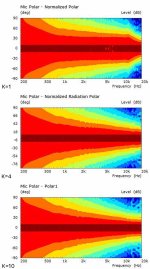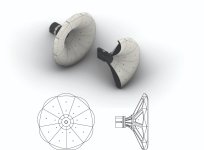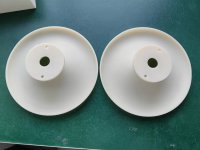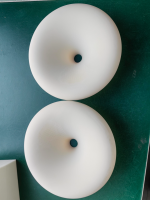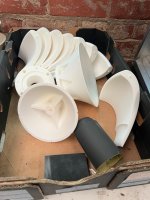I've been playing around with the formula and trying to understand how the variables might affect loading and dispersion - I simulated 3 horns, all with identical parameters except for K - where I did tests at K=1, K=4 (I think the Gen 2 Horn var.), and K=10. I used an exit angle of 0 to theoretically match the DCX464. I'm still rather new to this, so I don't exactly understand how these things would affect the horn loading, but the results are below - what is interesting is the magnitude of difference between K=4 and K=10 appears to be quite small, at least so far as I am understanding the graph (which I could be misinterpreting because I'm a complete amateur).
Attachments
I dont think you see any absolut magnitude in these. They are normalised in order to show relative directivity as a function of frequency. If one spread a certain amount of energy in a wide manner it will sound weaker than if the same amount of energy was more focused to one location. There is no magic 😉
//
//
Hi everyone
I've been watching this thread for a while and I must say that there is some amazing information, understanding and experience collected here about horns so please don't bag me too much!
I just printed out a ATH 420G2 kit on my Bambu Lab printer and am excited to start building it. I've seen the published results, done my own sims to compare and they look terrific.
Looking at the design I'm planning to build and then comparing it with what is done by Avant-garde raised a question that I was hoping someone here could help answer: What are the differences between using a CD and a regular driver (like AG) in a horn? The AG Duos use a mid-horn with a 'conventional' driver for 300-3.5kHz, a horn tweeter and some bass units.
Any suggestions?
I've been watching this thread for a while and I must say that there is some amazing information, understanding and experience collected here about horns so please don't bag me too much!
I just printed out a ATH 420G2 kit on my Bambu Lab printer and am excited to start building it. I've seen the published results, done my own sims to compare and they look terrific.
Looking at the design I'm planning to build and then comparing it with what is done by Avant-garde raised a question that I was hoping someone here could help answer: What are the differences between using a CD and a regular driver (like AG) in a horn? The AG Duos use a mid-horn with a 'conventional' driver for 300-3.5kHz, a horn tweeter and some bass units.
Any suggestions?
That's true but not the full story. Say around 800 Hz, those horns with k=1 and k=10 will have very different throat impedances, although the beamwidths will be already similar.If one spread a certain amount of energy in a wide manner it will sound weaker than if the same amount of energy was more focused to one location. There is no magic 😉
//
I tried to find a balance with the Gen2 horns. Hard to say if it's already an optimum but so far I really like the results.
I tried to recall but to no avail. I just don't remember, these were always more by-products than features, sorry.Is there in ATH the posibility for doing this with R-OSSE profiles for horizontal coverage, combined with plain (0°) base and lid?
I can imagine using a smaller woofer in a waveguide instead of a large direct-radiating one (to achieve the same level of directivity, say that of a 15" woofer). I wouldn't advise to use more than one high-frequency horn. Compression drivers are made and optimized for that use, I don't see any advantage in using anything else. You can now easily cover 600 - 20k virtually perfectly with a single source.Looking at the design I'm planning to build and then comparing it with what is done by Avant-garde raised a question that I was hoping someone here could help answer: What are the differences between using a CD and a regular driver (like AG) in a horn? The AG Duos use a mid-horn with a 'conventional' driver for 300-3.5kHz, a horn tweeter and some bass units.
Last edited:
Actually, I don't see why it's not useful. By setting the inclination of the diagonal you have a complete control. If set to zero it should do what you want (provided it still works at all).Marcel, in Post 11,545 you mentioned the "D=" for diagonal curvature when it comes to rectangular sources, but that´s not useful, when hight is much greater than width of the source.
So after following this thread for a while I decided to settle on the SB Audience Rosso CDN-T for a CD, and I purchased the files from your site to get the initial geometries. I modified the curve a tiny bit to accommodate a larger horn (about 600mm diameter) with a slightly higher K (I think 5 instead of 4) in order to try to squeak out a slightly lower F3 than the model on your site - not much, but around 600 would help my c2c spacing on the drivers. I rebuilt all of it so it was surfaces rather than a mesh, then shaped it so the majority of the horn can be fabricated out of wood, with a small 3d printed throat and throat insert like your model. Attached is the 3d model I'm working from - the biggest challenge IMO is going to be getting that last petal to fit without gaps. Using a CNC to cut the wood petals.
Attachments
After following this thread for a while and realizing I’m getting a bit too old and busy to design a waveguide myself, I decided to take the plunge and have these made. They’re the ST260, printed with an SLA printer, so 100% infill. I went with Somos Ledo Resin—it’s a bit more expensive, but known for its strength and smooth finish. I’ve always found FDM prints to be a highly unattractive, so I’m really happy with how these turned out! They were printed as a single piece without supports—no idea how they managed that, but they look great. Each one weighs 450 grams, so they’re pretty solid. They where made by Unionfab in China, a firma that is an absolute pleasure to deal with. Total costs including import taxes and shipping around €230,-. I could not find an adress anywhere near that could do it for less than €300,- to €350,- each in the same quality so it was worth it to go abroad. Next weekend I have time to give them a try.
Attachments
Well, design choices obviously. It is hard to find a comression driver that plays down to 300Hz. 600Hz can be done but that also puts other demands on the woofers that have to play into the midrange. Obviously Avantgarde has choosen for bass extension in a relatively small enclosure which implicates the use of heavy coned woofers with thick rubber surrounds which are in general not the best sounding match with compression drivers. So all in all, the use of a compresiion driver as low as possible would have ended up in a much bigger loudspeaker or a loudspeaker with much less low-end extension. Like all loudspeakers in the world, it's a compromise.Looking at the design I'm planning to build and then comparing it with what is done by Avant-garde raised a question that I was hoping someone here could help answer: What are the differences between using a CD and a regular driver (like AG) in a horn? The AG Duos use a mid-horn with a 'conventional' driver for 300-3.5kHz, a horn tweeter and some bass units.
Any suggestions?
Hi Sjef,
I fair observation I would say. My plan is to use the ATH460G2 with a woofer (150 - 700Hz) and a sub-woof for below 150Hz (not a separate) or something like that. Is there are standard / preferred design that people use with these horns?
BTW, your horns look fantastic - resin does seem to look much better than FDM.
I fair observation I would say. My plan is to use the ATH460G2 with a woofer (150 - 700Hz) and a sub-woof for below 150Hz (not a separate) or something like that. Is there are standard / preferred design that people use with these horns?
BTW, your horns look fantastic - resin does seem to look much better than FDM.
Last edited:
That is the ideal / intended design for these larger horns. A true multi-sub solution (with an overlap with the mains) may be technically the best but using just an additional driver for the lowest two or three octaves is still a good solution. People are often quite happy with even a two-way (the bigger ones already offer more than many need).
I just can't imagine crossing two horns in the higher-kilohertz range without big acoustical problems.
@mjhara - that's lovely. I'm really looking forward to see how it goes.
I just can't imagine crossing two horns in the higher-kilohertz range without big acoustical problems.
@mjhara - that's lovely. I'm really looking forward to see how it goes.
Last edited:
@mabat, first of all I have to construct the 420G2….which is still in pieces. One step at a time.
Attachments
Would be nice to have 720 and 620 as an option too. 52cm is slightly too small for my need when my target is to go to under 300Hz. If I understood right at least 620 would be possible to print with 330 size of a printer which is quite common size
I'm not sure that a bigger horn would help that much to reach that (pretty ambitious) target. You would gain something by narrowing further the beamwidth but I think this still wouldn't be enough.
I don't know how to evaluate such number, but it would probably not add more than 6 dB SPL anywhere (which corresponds to going from a full-space to half-space radiation), and this seems not enough to me. And I guess it will be noticeably less, actually.
Doubling physical size would drop acoustic features, features you see on the measurements, one octave down. So, if you scale 52cm device to 72cm, features of the response move roughly half an octave down. Response that was at 52cm wavelength is kow at 72cm wavelength. Since throat size needs to stay the same it's not quite as simple, but this is the basis you can easily imagine with. You can take frequency response files of one size device and make a python script with AI that takes in scaling factor as parameter and you can make various sized versions of it to quickly find suitable sized device. Then actually simulate one to verify. Physical shape and size is directly related to sound wavelength, wavelength is size of sound if you will.
Not so the throat impedance. So virtually the whole difference would be due to the DI curve shifting lower in frequency, i.e. the radiated power at say 400Hz being concentrated to a somewhat narrower angle with the bigger horn. I don't know the formula for that from the top of my head, it probably wouldn't be too difficult to derive.Doubling physical size would drop acoustic features, features you see on the measurements, one octave down.
- Home
- Loudspeakers
- Multi-Way
- Acoustic Horn Design – The Easy Way (Ath4)
